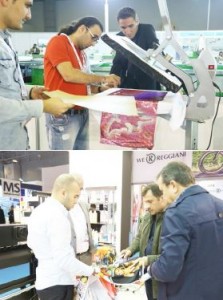As a leading producer of textile, Turkey has a very active tex tile market. Where traditionally, screen printing was the dominant technology, the evolution of digital has attracted attention from Turkish printers and presents them with new opportunities for business diversification. Results from the recent FESPA Print Census illustrated that 80% of respondents are very optimistic for their businesses which is great news for the industry. This confidence is on the back of revenue growth, which from 2007 to 2015 was about 9% CAGR for the overall business, and 7% for digital wide format.
tile market. Where traditionally, screen printing was the dominant technology, the evolution of digital has attracted attention from Turkish printers and presents them with new opportunities for business diversification. Results from the recent FESPA Print Census illustrated that 80% of respondents are very optimistic for their businesses which is great news for the industry. This confidence is on the back of revenue growth, which from 2007 to 2015 was about 9% CAGR for the overall business, and 7% for digital wide format.
Satisfying customer demands
The digital textile printing market is an area experiencing global growth and is one of the main trends exposed from the results of the FESPA Print Census. 27% of participants are already involved in garment printing and 81% see growth in this area, the highest of any growth application. From the Census it is also clear that digital technology is the enabler, as 21% of respondents plan to invest in digital textile printers. And, over half of respondents were of the opinion that the amount of digital printed garments will overtake that of screen printed garments in two years’ time. This growth in digital printing also means that when investing in new hardware, customers are looking for improved efficiency, enabling faster job turnaround, just-in-time delivery and personalisation. This is a trend mirrored in Turkish companies. Sales Manager of BTC, Bilgi Teknolojileri, Ufuk Mercan, notes that there are 35000 small to medium sized businesses in the Turkish textile and garment industry and it’s the second top supplier in the textile and garment market in Europe. Ufuk comments: “Where once screen and rotary printing were predominantly used in the print market, digital printing technology is rapidly expanding due to the change from mass production to personalisation. The ease of the production process also makes it an attractive option for printers.” This evolution of digital print technology has enabled more Turkish print companies to expand their business. Results from the Print Census suggest that this growth in digital will continue as half of the respondents stated they intend to invest in digital wide format printing equipment priced at Euro100,000.
The possibilities of textile print
Textile printing is booming in the graphic arts, garment decoration, interiors, signage and industrial printing markets. General Manager of Tecpro Bilgi Teknolojileri, İbrahim İlhan, who uses digital printing primarily for printing, patterns, design and proofing says: “Digital print technology including sublimation printing is increasing in popularity. The sublimation-based printing machines’ market share is 10-15%. But the number is continuously increasing.” The Census showed that when it came to buying intentions, 20% of respondents are focusing on investing in textile printing machines, with 12% planning to buy thermal transfer equipment. General Manager of AIT Saliha Özgür says, “This year we are experiencing high demand for transfer printed products and RIP software, which is very important for print process automation. The market is expanding and technology is changing quickly” Textile for décor and industrial applications is also booming. 78% of respondents reported a growth in interior decor applications such as home furnishings, curtains for residential or entertainment locations. Textile is also growing in the sign and graphics arena as 67% of respondents have observed growth in soft signage applications.
Huge opportunity
The ready-made garment sector is one of the top industries in Turkey and provides almost 20-25% of the export 1. The sector, which is based on intense manpower and technical developments increased its export by 7.3% and reached 30 billion Euros in 2014 1. Turkey has the only textile sector which increased its export by 6% in 2014, generating 8.9 billion dollars in total 1. Michael Ryan, Exhibition Manager at FESPA notes that the Turkish textile sector is continually improving and the use of textile printing is becoming more diverse, expanding beyond the traditional apparel and garment decoration purposes. “Textile is becoming more and more popular due to the end applications that can now be produced. Alongside traditional textile applications such as ready-made clothing and garment decoration, we are now seeing new end-uses including textile printing in furniture, flags and banners, interior and exterior decorative applications, as well as textile products for mobile and tablet covers. This sector is rapidly adapting itself to innovative technologies. The development of digital printing provides new opportunities for printers looking to expand into the textile market. Innovative inks, transfer sheets & materials, design and RIP software minimises the pressure of the printing process on the environment enabling printers to produce high quality prints with less cost.” For printers wanting to take advantage of this booming sector, FESPA Eurasia 2015, which will take place at CNR Istanbul, from 10-13 December 2015, will provide printers with the opportunity to meet with leading players in the textile printing sector covering both screen and digital printing.
 Tekstil Teknik Dergisi Tekstil Haberleri, Tekstil Sektörü, Tekstil Teknik
Tekstil Teknik Dergisi Tekstil Haberleri, Tekstil Sektörü, Tekstil Teknik




